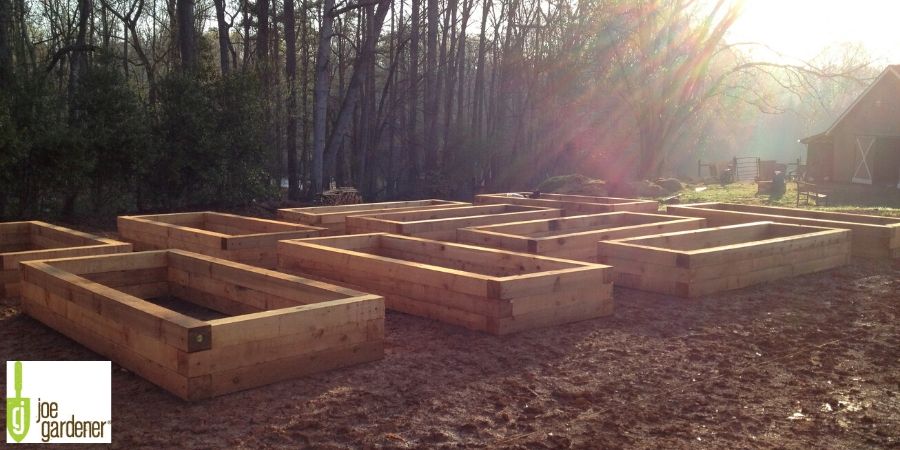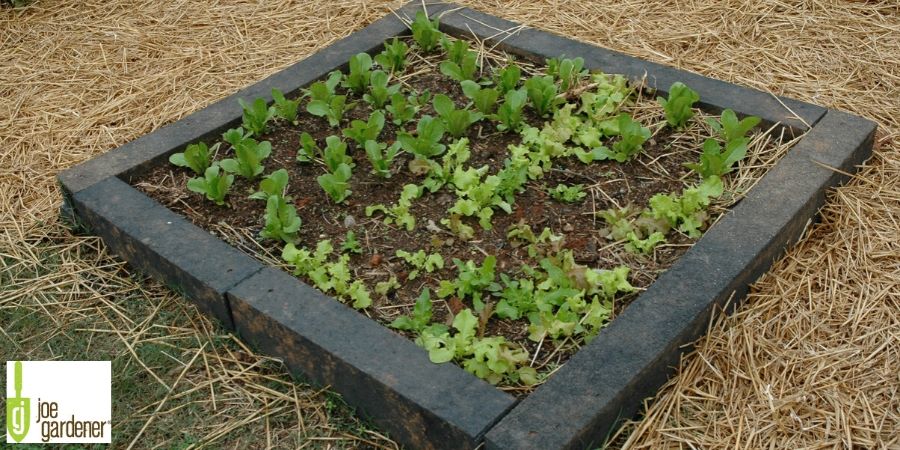Best Materials for Raised Garden Beds
- Gardening Expert and Host of Growing a Greener World®July 18, 2020
Why Use Raised Garden Beds?
If you’ve never gardened in a raised bed, you might be surprised at what a difference it makes for your success and overall enjoyment. A raised garden bed can be either mounded soil or a contained bed of soil above the surrounding grade. The goal is to create a deep, wide growing area that encourages plant roots to grow down and outward.
When your soil bed is elevated above the surrounding terrain, you control its health and drainage. It also brings plants closer to eye level to make it easier to notice signs of trouble. A raised bed environment provides significant advantages for success in spite of the constant challenges nature throws our way.

My vegetable garden consists of 16 raised beds using untreated 6" x 6" cedar timbers. Each bed is 12’ x 4’ and 18” high. I find them to be the perfect height and the large bed size provides many options for planting.
Which Materials Are Safe for Containing Your Garden Beds?
A raised bed of mounded soil is certainly the easiest way to get started, but it has long-term drawbacks. Without some type of enclosure to maintain the integrity of the bed, you should expect to spend more time maintaining the mounded shape as wind and rain cause erosion. Be prepared to spend more time-fighting weed intrusion as well.
If you opt to contain the soil of the bed, your material options are nearly unlimited, however, there are some important considerations to keep in mind.
Why do materials matter? First of all, the materials you use will be in close quarters to your food crop. In all likelihood, the roots and foliage will be regularly making contact with your material surface.
Secondly, the soil you place within your bed will need to remain fairly moist, and the exterior surfaces of your bed will be spending a lot of time in the hot sun. Most materials degrade when exposed to constant moisture and/or sunlight.
There are so much conflicting information and surprisingly few studies on the various materials available for use. However, there are some basic pros and cons to the materials you may be considering.
Best Wood for Raised Gardens
Raw Wood
The best types of untreated wood are cypress, cedar, redwood, oak, black locust, or osage orange. These woods can be difficult to find in some areas, and they tend to be expensive. However, their rot-resistant properties mean these wood options can last for many years - even under moist conditions.
Oftentimes, these woods are harvested from an old-growth forest. If you choose to use one of these woods, check that it is coming from a sustainable source. Look for the Forest Stewardship Council (FSC) certification on any wood you buy. The FSC is an international organization that has developed standards for responsible forest management.
Untreated pine is a less expensive and more sustainable untreated option, but it will also have a shorter lifespan.
All types of untreated wood will need to be replaced at some point. The lifespan will depend on wood type and your environment. If you live in a hot and muggy area, untreated wood may only see you through a couple of years. The same wood in an arid climate can last for several years.

I chose untreated cedar because I grow organically, so for my purposes the untreated wood is important and cedar is a good rot-resistant option.
Treated Wood
Treated wood has been infused with chemical elements to preserve the wood. The primary concern with treated wood is that those elements leach out into the soil. CCA (Chromated Copper Arsenate) wood used to be the most commonly available product. Concerns over the arsenic in CCA led to its discontinued availability for residential applications in 2003..
Although you may find older CCA-treated wood, today’s retail options will more likely be ACQ (Ammoniacal Copper Quat). It has a higher concentration of copper but no arsenic.
Leaching of the chemicals from any treated wood occurs at the highest levels under the following conditions:
- Smaller surfaces - i.e. the ends and - especially, the sawdust
- More recently treated (although CCA-treated wood is shown to retain uniformly-high levels of CCA)
- Moist conditions - i.e. after a rain or in a muggy environment
In fact, studies exploring the impact of treated wood when used for raised beds have shown that the greatest risk is actually in touching the exterior of the bed. When you (or especially, your kids) sit on or lean on treated wood, your skin or clothing is likely to absorb the copper or arsenic leaching out of the wood to remain on the surface.
Composite Wood
Composite wood is made of recycled materials and can last for years. Here again, there hasn’t been much research on the use of this material in close proximity to edibles. It appears to be a benign product for garden use, but there isn’t much information out there to make a solid determination.
One thing is certain: Some composite material has a tendency to buckle when used in long side walls. So, it may not be the best option for large raised beds.

While I could have used less beefy timbers and saved some money, I knew I wanted these beds to last as long as possible, plus, they get used a lot for year-round growing and filming for my television show and videos. I plan on gardening the rest of my life, so making this investment made sense for several reasons. Plus I love how they look!
Other Garden Bed Materials
Railroad Ties
Railroad ties are made with creosote, an oil distilled from coal tar. Creosote is a wood preservative for industrial use and is the black, oily stuff you see oozing from the sides of the tie.
The heft of this material has made it a popular choice for raised beds and garden retaining walls. There have been few studies on the impact of using them to contain edible plants, but consider the advice provided directly from the EPA on creosote.
“...Creosote is not approved to treat wood for residential use, including landscaping timbers or garden borders… Creosote is a possible human carcinogen and has no registered residential use."
Cinder or Concrete Blocks
Currently, these two terms are used interchangeably. If your “cinder” blocks are decades old, they may actually be cinder blocks, but only concrete blocks have been in production for the past 50+ years.
These days, nearly all concrete (cinder) blocks are made of what’s called Portland cement along with sand, gravel, or some other aggregate. Portland cement is made with fly ash (ranging from 15% to 25%) to make concrete blocks lighter yet stronger.
Fly ash is a petroleum byproduct - a fine powder byproduct of coal burning. It contains various amounts of toxic metals; including arsenic, lead, and mercury. So, yes, those metals are in the concrete blocks that line your vegetable garden too. Not much research has been done on this specific subject, but it’s believed that those metals are only likely to incorporate with the soil if part of the concrete block is pulverized.
So if you opt to use concrete blocks in building your raised bed, be sure to avoid anything that would cause them to break and release their dust into the soil.

A single layer of wood, such as these treated and stained 6 x 6 timbers provide enough height for most vegetables, especially leafy crops such as this lettuce.
Stone
As a natural product, there are certainly no potential health risks in using stone for your raised bed walls. However, if you choose to mortar the stone for additional stability, consider that the mortar product may bring some of the same risks as concrete blocks.
This can be an expensive and more time-consuming option, but it will also last for many more seasons than most other materials.
Galvanized Metal
The galvanization process typically involves dipping the metal in molten zinc or zinc-based coating. While dangerous if consumed in large quantities, zinc is a micronutrient that plants and humans actually need in small quantities.
There’s little scientific information available examining the effect of galvanized metal in the use of raised beds either. That said, an excess of zinc leached into the soil would probably reflect in dying plants, before it would ever pose a health risk.
Also, galvanized metal has been used to hold or transport water for humans and livestock for many years. That doesn’t mean this product is safe from any negative health impact, but the risk is certainly low.
If you opt to use galvanized metal, be mindful of heat and drainage. Livestock troughs are a popular option, but it’s important to add plenty of drainage holes in the bottom of the trough. Water will need a place to escape so as not to drown plant roots.
Metal will absorb and reflect more heat from the sun than other materials. As a result, your soil will tend to dry out more quickly, and foliage in the line of that reflective power might suffer. The soil nearest to the sun-facing metal will also warm up more than the rest of the bed.
Consider planting tender vegetables - like lettuce - toward the center of the bed where soil temperature will remain mostly constant.
Tires
Are you considering using tires? Well, just don’t do it. Tires are a petroleum-based product. Their rubber degrades in the heat and moisture of a garden environment, and the chemicals incorporate into your soil. They may be convenient or look resourceful and fun. It may keep a tire out of the landfill, sure. But there are more drawbacks to using tires than there are benefits.
There’s a reason that most landfills prohibit tires. If garbage shouldn’t be subjected to decomposing tire rubber, neither should your family’s food.
Don’t Shirk on Soil
Hopefully, this list of considerations helps you as you plan your new raised bed garden. Once the structure is in place, you might be tempted to cut financial corners when you get ready to fill it with soil. That would be a big mistake.
New gardeners often underestimate the importance of investing in quality soil. However, it’s the single most important step for creating a healthy garden. Set aside enough of your budget that you can purchase quality soil. Then feed that soil, so it will feed your plants.
During the first season, amend the new soil with about 30% compost and a sprinkling of a non-burning, slow-release, organically-derived source of nitrogen fertilizer like Milorganite®. There are other good amendment options that will boost plant production even further. Consider it a soil recipe for a successful garden. Then, keep soil healthy by amending the bed at least once a year at the beginning or end of the growing season.
You’ll be rewarded with healthy, robust plants season after season.

